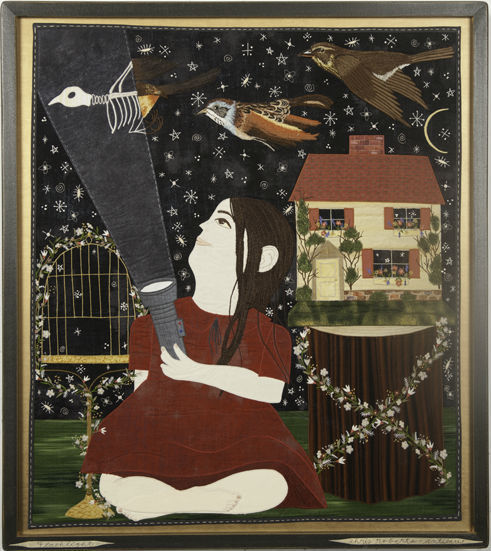Chris Roberts-Antieau, telling stories with fabric
Telling stories with fabrics comes naturally to Chris Roberts-Antieau. She uses bits of fabrics for her paintbox and creates wonderful narratives that illustrate her world and ours. An extremely successful artist, her works are shown in over a hundred galleries nationally and too many museums to mention. Oprah and Lyle Lovett and Gillian Welch and a many other Notables collect her. She’s in the Boxing Hall of Fame with a tribute piece she did of Sugar Ray Robinson and she’s hanging in the White House with a portrait of George Washington.

From the Gathering Stars collection, Flashlight.
Chris Roberts-Antieau began her career in art by walking out of an art class.
On her very first day in art-school, the instructor had given the class an assignment to draw an ink bottle. The other students drew literal, realistic sketches. Chris drew a blocky, childlike bottle that took up the whole page. The professor singled it out for mockery in front of the whole class, asking her, “Who told you you could draw?” Chris walked out and never looked back.
Marriage and the birth of her son, Noah, put her art on hold for a few years. But when Noah was old enough to hold a crayon, the two of them began to draw together. Chris found herself fascinated by the raw childlike vision she saw in her son’s drawings, and it wasn’t long before she herself was “back at the drawing board,” creating fanciful cloth sculptures for regional art shows. Her first sale: a trapeze artist, which took her two days to make, and sold for $18.

From the Blues Collection, a portrait of Muddy Waters, above.
Barely a year later, a visiting artist ran across Chris’s work and suggested that she take a crack at creating designs for the then-hopping wearable art market. Chris took her up on it, creating 2 jackets and 3 vests, which the two took to Baltimore, for the American Craft Enterprises event, Chris’s first show ever outside her home state of Michigan.
The response was overwhelming. Buyers crowded a dozen deep around the makeshift booth, elbowing each other for place. When the smoke cleared, Chris had hundreds of orders from stores across the country, including Neiman Marcus. She returned home, hired a staff of fifteen, and set out to meet her commitments, doing the complicated and time-consuming detailing on each garment herself.

From the Phantom Limb collection, Phantom Limb, above.
I’m An Artist
At the end of that year, Chris had a thriving business, but she was miserable. She wanted to be an artist, not a manufacturer. Wearable art took up an enormous amount of time in management and production. And it wasn’t like other fine art: people didn’t just care about the design–they wanted it to match their new shoes, or favorite sweater, too.
So despite her remarkable success, Chris left the wearable art world and spent the next year exploring other options from her Ann Arbor studio. Again, it was a chance comment from a friend that set her on a new track. Chris had been struggling to find a medium, torn between her roots in sculptural objects, and the freedom she?d found in her flat designs for wearable art. “It doesn’t have to be on a jacket to be flat,” her friend suggested. “Why don’t you make something to hang on a wall?”
Fabric Paintings
The next year, Chris returned to Baltimore’s American Craft Enterprises show with the pieces that have now become her hallmark: fabric paintings composed from freehandcut cloth shapes, hung behind glass in hand-painted frames. Response to these unique pieces was strongly positive as well. Today, a dozen years later, the best art galleries across the country offer her work, which has also won major awards at the prestigious Ann Arbor and St. Louis Art Fairs, and the attention of HGTV, O the Oprah Magazine and Mary Engelbreit’s Home Companion Magazine.
True to her roots, Chris’s gaze is still distinctly child-inspired. Her compositions have the delightfully off-kilter feeling of children?s drawings, and the subjects sometimes seem to be a child?s choosing as well: Playing With Dolls, Bad Dog, or Bug Jar. But like her better-known inspirations, Picasso, Miro, and Van Gogh, Chris takes the honesty, freedom, and new perspective of children’s art to a new level. She doesn’t just mimic a child’s style she applies a child?s eye to adult realities, reminding viewers not to take themselves too seriously, and giving them a chance to remember again the wonder and joy that children find in the everyday. “People always want to know what my work is about,” Chris says. “But I’m an artist, not a writer. If I could put it into words, then I wouldn’t have to make the pictures.” Everyone who sees her art brings something different to it, she believes, and she's happy with that.
But while the meaning of a given piece may not be clear-cut, Chris does have some sense of what she's trying to get across. “My vision of the world is joy-based,” she says. “Even when awful things happen to me, I’ve found wonderful things along the way. That’s what my art is about: the joy and wonder and humor that’s all around us, every day.”
Chris Roberts-Antieau
Sept 26, 2015
